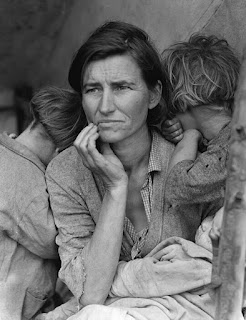Welcome back viewers
This month's Iconic Image is...
Migrant Mother
This article is dedicated to my own Migrant Mother (Amy Louise Haseltine). The very best I could ever have.
Intro
Part I
On October 29, 1929, Black Tuesday occurred in New York City. On that day, American investors traded some 16 million shares on the New York Stock Exchange. This caused more than $14 billion of stock value to be lost. This in turn, wiped out thousands of investors across the United States. Multiple jobs were lost and the unemployment rate skyrocketed around the world. This was the beginning of the Great Depression.
At its height more than 12 million American citizens (24.9 % of the nation's workforce) were unemployed. The wages for income workers fell more than 42% from 1929 to 1933. This caused many people (especially single parents with children) to move to different areas of the country. It was especially bad in the midwest region of the country when a severe drought (now referred to as the, "Dust Bowl") rolled in.
Part II
By the year 1936, a New Deal agency had been formed to help poor families relocate to better homes. It was called, the Resettlement Administration, later the Farm Security Administration (FSU). In March, a photographer from the FSU decided to leave the studio and try to capture the situation around her. Her name was, Dorothea Lange.
Lange was a graduate from Columbia University. She and the FSU had already taken thousands of photographs of people who had been affected in the rural areas by the Great Depression. While she was driving north of Los Angeles, Lange spotted a sign for a migrant workers' campsite. She then decided to pull over and talk to the people inside the camp. She spotted a young women with four children sitting in small tent. Lange approached the mother and asked for permission to snap some photographs of her and her kids. The mother gave her consent and Lange snapped a sequence of six photographs of the family around the tent.
For the final picture, Lange asked two of the younger children to turn their backs to the camera and place their hands on their mother's shoulders. She then told the mother to hold her baby with one hand and to use her right hand to rest her chin. Lange then told the mother to draw her gaze away from the camera. Lange then moved closer and focused the mother at the center of the camera frame in order to exclude any other backround so that she and her children were the only ones visible. After taking this photograph, Lange closed her camera, thanked the mother and the children, and departed from the campsite. According to Lange she had only been there just over 10 minutes.
Part III
After the publication of the photographs, there were many attempts to find the identity of the Migrant Mother. But her identity would not be discovered until the year 1978, when an elderly women wrote a letter to the editor of the Modesto Bee newspaper. Her name was, Florence Owens Thompson. She was born on September 1, 1903, in Oklahoma. She was a full-blooded Native of the Cherokee Tribe. In the mid-1920s Florence married a man named Cleo Owens. With him, she had given birth to six children.
Tragically, Cleo Owens died of tuberculosis in 1931. This left Florence as a single mother to six young children. In order make a living, she and her children turned to picking crops and cotton. The stress of the Great Depression, the death of her husband, and keeping her six children alive caused to age beyond her years. When Florence was photographed by Dorothea Lange, she was only 32 years old, yet she resembled a middle aged woman.
Epilogue
Almost immediately after taking the photographs, Lange returned to the Resettlement Administration and got them developed. Soon after, Lange published them in the San Francisco News. The images instantly captured the attention of the entire country. In response to the story that was published about the Migrant Mother and her family, the US government announced that it was going to send 20,000 pounds of food to the pea-pickers' campsite. Sadly, by the time it arrived, the mother and her children had already moved on from the camp.
For more than four decades, the identity of the Migrant Mother was never known. Even as her image was printed on stamps and magazine covers, it seemed like she had simply vanished into the vast American populace. It wasn't until the year 1978, that Florence Thompson finally came forward by writing a letter to the editor of the Modesto Bee newspaper. A year later, she gave an interview for the Nebraska Public Television. After the Great Depression, Florence remarried and had four more children. She lived the rest of her life in California before dying on September 16, 1983.
Dorothea Lange was praised for her photographs taken of the family at the pea pickers' campsite. Dorothea continued to work as a photographer and photojournalist for the rest of her life. She died on October 11, 1965. Today, her photograph of the Migrant Mother continues to inspire and influence people all around the world. It is credited with successfully humanizing the toll that the Great Depression had taken on the American people. It is also considered to be the main influence behind the development of documentary photography and remains a solemn remainder one of the most difficult periods in American history.
https://www.pbs.org/wgbh/roadshow/stories/articles/2014/4/14/migrant-mother-dorothea-lange/
https://www.moma.org/collection/works/50989
https://www.history.com/news/migrant-mother-new-deal-great-depression#:~:text=From%20the%20moment%20it%20first,Americans%20during%20the%20Great%20Depression.
https://www.nytimes.com/2018/11/28/lens/dorothea-lange-migrant-mother.html
https://www.history.com/topics/great-depression/1929-stock-market-crash

No comments:
Post a Comment